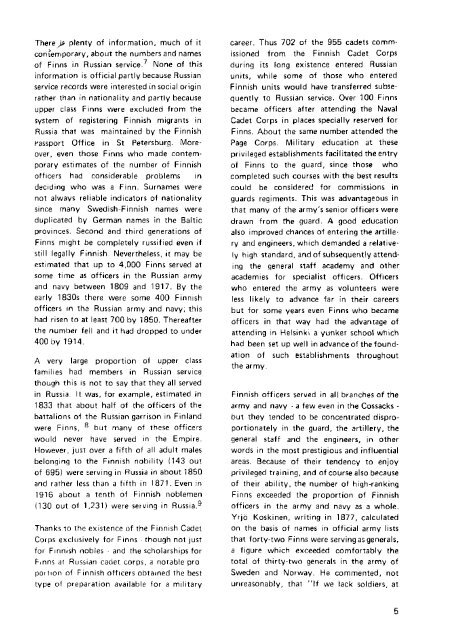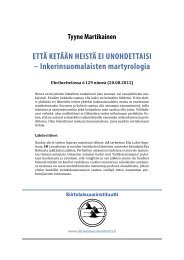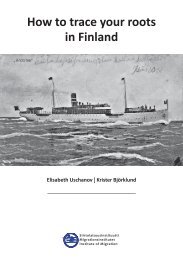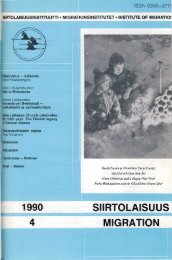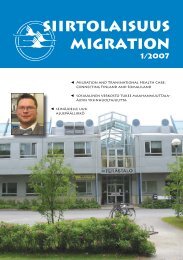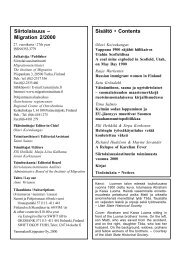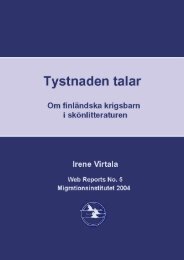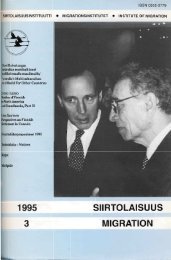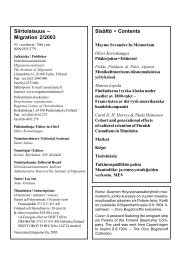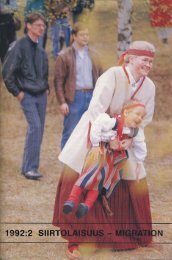1981 - 4 - Siirtolaisuusinstituutti
1981 - 4 - Siirtolaisuusinstituutti
1981 - 4 - Siirtolaisuusinstituutti
Create successful ePaper yourself
Turn your PDF publications into a flip-book with our unique Google optimized e-Paper software.
!-.<br />
Therei plenty of information, much of it<br />
coniemporary, about the numbers and names<br />
of Finns in Russian service.T None oI this<br />
information is official partly because Russian<br />
service records were interested in social origin<br />
rather than in nationality and partly because<br />
upper class Finns were excluded trom the<br />
system oJ registering Finnish migrants in<br />
Russia that was maintained by the Finnish<br />
Passport Office in St Petersburg. More'<br />
over, even those Finns who made contemporary<br />
estimates of the number of Finnish<br />
oflrcers had conside'able problems in<br />
deciding who was a Finn. Surnames were<br />
not alwavs reliable indicators of nationality<br />
since many Swedish Finnish names were<br />
duplicated by German names in the Baltic<br />
provinces. Second and third generations of<br />
Finns might be completely russified even if<br />
still legally Finnish. Nevertheless, it may be<br />
estimaled that up to 4,000 Finns served at<br />
some time as officers in the Russian army<br />
and navy between 1809 and 1917. By the<br />
early 1830s there were some 400 Finnish<br />
officers In the Russian army and navy; this<br />
had risen to at least 700 by 1850. Thereafter<br />
the number fell and it had dropped to under<br />
400 by 1914.<br />
A very large proportion of upper class<br />
ianrrlres had members ,n Russian !ervice<br />
thoLrgh this is not to say that they all served<br />
in Russia. lt was, for example, €stimated an<br />
1833 that about half o{ the o{ficers of the<br />
battalions ol the Russian garrison in Finland<br />
were Finns, I brt -any oJ lhese officers<br />
would never have served in the Empire.<br />
However, just over a fifth oi all adult males<br />
belonging to the Fannish nobility (143 out<br />
of 695) wer€ serving in Russia in about 1850<br />
and rather le55 than a tifth in 1871- Even in<br />
1916 about a tenth ol Finnish noblemen<br />
(130 out of 1,231)were serving in Russia.9<br />
Thanks to the existence of the Finnish Cadet<br />
Corps €xclusively for Finns though not just<br />
for Frnnish nobles and the scholarships lor<br />
F,nns at RLrssian cadet corps, a notable pro<br />
porlron of Finnish ofircers obtarned the besl<br />
type of preparation available lor a military<br />
career. Thus 7OZ of the 955 cadets commissioned<br />
trom the Finnish Cadet Corps<br />
during its long existence entered Russian<br />
units, while some of those who entered<br />
Finnish units would have transferred 5ubsequently<br />
to Russian service. Over 100 Finns<br />
became officers alter attending the Naval<br />
Cadet Corps in places specially reserved for<br />
Finns. About the same number attended the<br />
Page Corps. lvlilitary education at these<br />
privileqed establishments tacilitated the entry<br />
of Finns to the guard, since those who<br />
completed such courses with the best results<br />
could be considereC for commissions in<br />
gudrds regiments. This was advantageous in<br />
that many of the army s senior officers were<br />
drawn from the guard. A good education<br />
also improved chances of entering the artille'<br />
ry and engineers, which demanded a relatively<br />
high standard, and of subsequeotly aftend-<br />
ing the general stalf academy and other<br />
academies for specialist officers. Officers<br />
who entered the army as volunteers were<br />
less likely to advance far in their careers<br />
but for some years even Finns who became<br />
oflicers in that way had the advantage of<br />
attending in Helsinki a yunker school which<br />
had been set up well in advance of the found-<br />
ation of such establishments throughout<br />
the army.<br />
Finnish officers served in all branches of the<br />
army and navy - a few even in the Cossacks -<br />
but they lended to be concentrated disproportionately<br />
in the guard, the artillery, the<br />
general stalf and the engineers, in other<br />
words in the most prestigious and influential<br />
areas. Because of their tendency to enjoy<br />
privileged training, and oI course also because<br />
of their ability, the number of high-ranking<br />
Finns exceeded the proportion oJ Finnish<br />
officers in the army and navy as a whole.<br />
Yrjd Koskinen, writing in 1877, calculated<br />
on the basis of names in official army lists<br />
that forty-two Finns were serving as generals,<br />
a figure which exceeded comfortably the<br />
total of thirty-two gen€rals in the army o{<br />
Sweden and Norway. He commented, not<br />
unreasonably, thal "lf we lack soldiers. at


